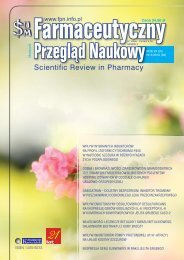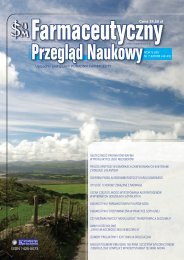Pokaż cały numer - Farmaceutyczny Przegląd Naukowy
Pokaż cały numer - Farmaceutyczny Przegląd Naukowy
Pokaż cały numer - Farmaceutyczny Przegląd Naukowy
You also want an ePaper? Increase the reach of your titles
YUMPU automatically turns print PDFs into web optimized ePapers that Google loves.
Farm Przegl Nauk, 2009,2<br />
DISCUSSION<br />
Oxidative stress is known to affect tissue metabolism<br />
[38,39]. It participates in pathogenesis of inflammation<br />
[40,41] and diabetes [41,42], promotes carcinogenesis [1]<br />
and induces cellular senescence resulting from accumulation<br />
of oxidative damage in DNA, lipids and proteins [43].<br />
Collagen, which accounts for about one third of total body<br />
proteins is essential not only for the maintenance of the connective<br />
tissue, but also for interaction with integrins. Activation<br />
of these receptors by extracellular matrix proteins, e.g.<br />
collagen, regulates cellular gene expression, differentiation,<br />
cell growth [44] and plays an important role in wound repair<br />
[45], tumorigenicity and invasiveness [46].<br />
This study suggests, that oxidative stress exerts inhibitory<br />
effect on collagen biosynthesis in human dermal fibroblasts.<br />
Similar effect on collagen production was previously<br />
demonstrated in human cardiac fibroblasts exposed to varying<br />
concentrations of hydrogen peroxide or xanthine plus<br />
xanthine oxide [7]. In order to explain the mechanism of this<br />
process, we considered prolidase as a target enzyme.<br />
Prolidase activity has been demonstrated to play an important<br />
role in regulation of collagen biosynthesis in fibroblasts<br />
[10-12]. In fact, the enzyme expression was decreased<br />
in fibroblasts exposed to t-BHP. Decreased prolidase expression<br />
in these cells was accompanied by a decrease in the expression<br />
of phosphorylated FAK protein. The correlation is<br />
well known phenomenon. Activation of β 1 -integrin receptor<br />
that is known to increase in prolidase expression and activity<br />
[16, 36] leads to phosphorylation of FAK [17]. Therefore<br />
decrease in expression of FAK in t-BHP treated fibroblasts<br />
may explain decrease in prolidase expression. Similarly decreased<br />
expression of MAP- kinases (ERK 1 and ERK 2 ) was<br />
observed in t-BHP treated cells.<br />
Extracellular signal-regulated kinases pathway constitutes<br />
a major one, through which growth factor receptors<br />
transmit signals to the nucleus. It is known, that some growth<br />
factor receptors (EGFR, PDGFR or T-cell receptor) undergo<br />
phosphorylation in response to treatment with oxidants.<br />
Their phosphorylation leads to activation of p44/42 MAPK<br />
signaling pathway [47-52]. However, it has been recently<br />
shown, that oxidative stress can variously modulate ERKs<br />
activity in a time- and dose-dependent manner [53,54]. In<br />
addition, reactive carbonyl compounds, glyoxal and methylglyoxal<br />
formed extensively in conditions of oxidative stress<br />
have been demonstrated to be capable of dephosphorylation<br />
of intracellular phospho-ERKs, what results in their inactivation<br />
[55].<br />
IGF-I receptor is a receptor-tyrosine kinase that plays a<br />
critical role in signaling that leads to cell survival and proliferation.<br />
It is also a strong stimulator of collagen and DNA<br />
biosynthesis [21, 26]. It has been proposed, that activation<br />
of this receptor may protect different cells from oxidative<br />
stress [56-58] and regulate their resistance to the action of<br />
oxidants [59].<br />
We found that down-regulation of IGF-I receptor expression<br />
in fibroblasts submitted to oxidative stress was accompanied<br />
by parallel changes in expression of both MAP-kinases<br />
(ERK 1 and ERK 2 ). Simultaneously, DNA biosynthesis<br />
in fibroblasts treated with t-BHP decreased during the time<br />
32<br />
course of the experiment. In view of these data it seems that<br />
decrease in collagen biosynthesis and cell division caused<br />
by oxidative stress may be mostly a consequence of disturbances<br />
in β 1 -integrin and IGF-I receptor signaling.<br />
References<br />
1. Kawanishi S., Hiraku Y., Oikawa S. Mechanism of guanine-specific<br />
DNA damage by oxidative stress and its<br />
role in carcinogenesis and aging. Mutat. Res. 2001; 488:<br />
65-76.<br />
2. Mazhul V., Shcherbin D., Zavodnik I., Rękawiecka K.,<br />
Bryszewska M. The effect of oxidative stress induced<br />
by t-butyl hydroperoxide on the structural dynamics of<br />
membrane proteins of chinese hamster fibroblasts. Cell<br />
Biol Intern. 1999; 23: 345-350.<br />
3. Stadtman E.R. Protein oxidation and aging. Science 1992;<br />
257: 1220-1224.<br />
4. Dean R.T., Thomas S.M., Vince G., Wolff S.P. Oxidation<br />
induced proteolysis and its possible restriction by some<br />
secondary protein modifications. Biomed Biochim Acta.<br />
1986; 11-12: 1563-1573.<br />
5. Monboisse J.C., Gardes-Albert M., Randaoux A., Borel<br />
J.P., Ferradini C. Collagen degradation by superoxide<br />
anion in pulse and gamma radiolysis. Biochim Biophys<br />
Acta. 1988; 965: 29-35.<br />
6. Kawaguchi Y., Tanaka H., Okada T., Konishi H., Takahashi<br />
M., Ito M., Asai J. The effects of ultraviolet A and<br />
reactive oxygen species on the mRNA expression of<br />
72-kDa type IV collagenase and its tissue inhibitor in<br />
cultured human dermal fibroblasts. Arch Dermatol Res.<br />
1996; 288: 39-44.<br />
7. Siwik D.A., Pagano P.J., Colucci W.S. Oxidative stress<br />
regulates collagen synthesis and matrix metalloproteinase<br />
activity in cardiac fibroblasts. Am J Physiol Cell<br />
Physiol. 2001; 280: 53-60.<br />
8. Gumbiner B.M., Yamada K.M. Cell-to-cell contact and<br />
extracellular matrix. Curr Opin Cell Biol. 1995; 7: 615-<br />
618.<br />
9. Plow E.F., Haas T.A., Zhang L., Loftus J., Smith J.W. Ligand<br />
binding to integrins. J Biol Chem. 2000; 275: 21785-<br />
21788.<br />
10. Pałka J., Miltyk W., Karna E., Wołczyński S. Modulation<br />
of prolidase activity during in vitro aging of human<br />
skin fibroblasts the role of extracellular matrix collagen.<br />
Tokai J Exp Clin Med. 1996; 21: 207-213.<br />
11. Miltyk W., Pałka J.A. Potential role of pyrroline 5-carboxylate<br />
in regulation of collagen biosynthesis in cultured<br />
human skin fibroblasts. Comp Biochem Physiol A.<br />
2000; 125: 265-271.<br />
12. Muszynska A., Pałka J., Gorodkiewicz E. The mechanism<br />
of daunorubicin-induced inhibition of prolidase<br />
activity in human skin fibroblasts and its implication<br />
to impaired collagen biosynthesis. Exp Toxicol Pathol.<br />
2000; 52: 149-55.<br />
13. Myara I., Charpentier C., Lemonnier A. Prolidase and<br />
prolidase deficiency, Life Sci. 1984; 34: 1985-1998.<br />
14. Yaron A., Naider F. Proline-dependent structural and<br />
biological properties of peptides and proteins. Crit Rev<br />
Biochem Mol Biol. 1993; 28: 31-81.

















